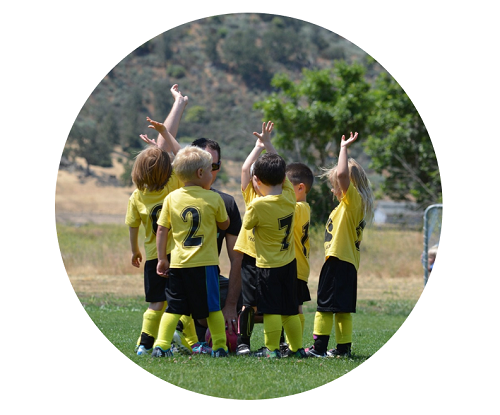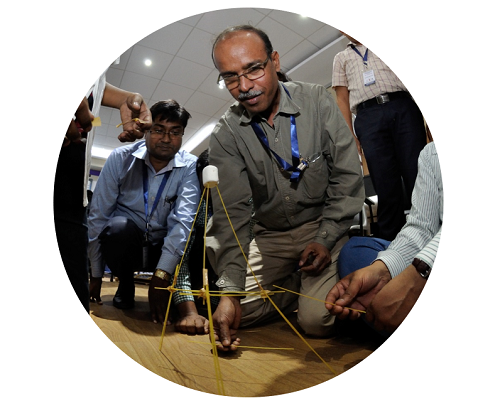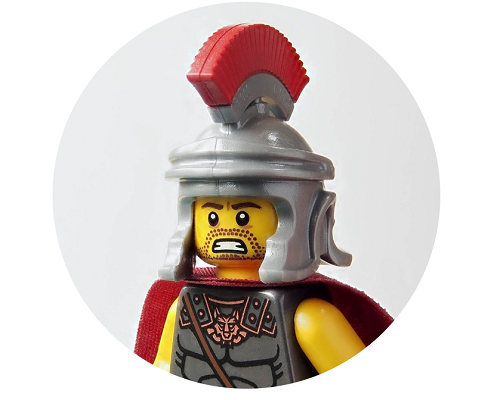When someone's productivity arouses interest
Surely each of us has ever thought about what kind of dream team it is? Ocean's cool friends team? Or the team of the French national football team? Or maybe the development team from Google?
In any case, we would like to be in such a team or even create it. Well, against the background of all this, I want to share with you a little experience and a vision of that very dream team.

The stars came together so that my dream team is using agile methodology, so everything I write here is more about agile teams. But who knows, maybe this article will help children with good imagination who do not needthis agile.
I want to dwell on the three main connecting teams that I consider must have: self-organization, joint solutions and mutual assistance. We will not take such parameters as the size of the team or roles in it. We believe that we have a team with this and so everything is good.
Self-organization. How to understand that you have already achieved it or how to achieve it?
If your team does not have an evil Pinocchio with a whip, and you manage to close all tasks together, then you can read the next paragraph.
I believe that the key to achieving this goal lies, firstly, in the personal acceptance of the team atmosphere (its rules and customs), and secondly, in the work on self-organization of each participant. Probably, somehow you can contribute to the development of this direction through dedication to the team, regular teambuilding and all sorts of rewards (not just for sure). The main thing is not to overdo it and not to demotivate teammates.
By the way, I know a couple of good games that will help strengthen self-organization in the team: Marshmallow Challenge and Ball Point Game. In these games, at least two teams are needed - it is advisable to attract a team from outside here. In the first game in time, you need to assemble such a stable structure so that the marshmallow is raised as high as possible above the table. And in the second game, you need to iteratively (from sprint to sprint) increase the number of balls produced in your factory. I had a chance to play these games, and this is a very good experience!

In the Marshmallow Challenge, our team did not take first place, but I liked the course of our game. Here is what interesting I saw here:

In the Ball Point Game (aka Ball Factory), our team won and we produced about 140 balls in a couple of minutes (there are rumors that there is a team that made about 300 balls). Self-organization did not occur by pressing the magic button. It appeared intuitively and was based on our universal goal of “more balls in the same time”. We greatly lost performance on the penultimate sprint (crashed into acorkscrew storming), sacrificing it for the sake of a dramatic improvement. Which in the end allowed us to win.
Joint decisions. What is it?
This is when a team, making decisions, at least is interested in the opinion of each participant. Even if someone is not yet competent enough, you can at least explain where we are being taken. Do not forget about mutual respect. Well, in the case of deadlocks, you can always play good old-fashioned poker scrum.
Mutual assistance.
You must admit that when you come to a team as a newcomer, and nobody explains anything to you, a wacky feeling of hopelessness arises (followed by thoughts like “maybe it ...”). And to prevent this, here, I think, there must be two important components:
Well, already feel how cool your team is? It's okay, now let's see what can help us.

Location.
Yes, it’s an incubator. And to be more precise - one single location. The most important thing in my opinion, where to start “pulling together” a team is its close location to each other. And even better, if it is a separate room and none of the huge space bothers you. Firstly, some minor problems are solved "on the fly", and not put off the shelf. Availability of a teammate at arm's length is much more profitable than access limited by skype. Secondly, the atmosphere of teamwork reigns in the room. You feel that you are benefiting the project, and a comrade sitting and working next to you too. This is about the same as when we were a child in a crowd made a snowman or made a house out of snow, digging it out in a huge snowdrift. Moreover, everyone brought some improvement on their own and everyone was fine.
I had the opportunity to work for 9 months away from my team. This is extremely inconvenient. My work dragged on. My tasks hung in In Progress state longer than most tasks of my teammates. It felt like they were making a fiftieth snowman together there, and I'm sitting here and still trying to plan a carrot for the first one. In general, productivity is the level of a snail.
But when I moved to the team, the situation changed radically. I felt "at the forefront of the attack." In a couple of weeks I began to close more tasks than I did in a month. I was not even afraid to take on the task of the middle!
Empathy and general atmosphere.
Do not stay away when a teammate is ambushed. Mutual respect, and just a good relationship with each other is also a kind of key to success. Ideally, there should be joy for the success of a teammate and pride in your team - and this is already a good motivation for further advancement.
It reminded me of a video where a crowd of passers-by together was able to push parked cars that prevented the ambulance from passing. They did this together, and they were able to move two cars that stood on the handbrake. This is really cool. And I think after success, everyone felt inside their usefulness to the process, felt that he had contributed more serious help.
For me, the worst dream is when an awkward situation reigns in the team and almost everyone is afraid to say a word, so as not to make a mistake somewhere or seem silly or dumb. This should not be. I understand that everyone has a different character, but each member of the team should feel comfortable in it.
The antidote to the situation described above, and simply communicating with the team in an informal setting will be just good prevention . It is communication, not spending free time, where everyone buried themselves in their smartphone. It will not be superfluous to get together with the team in the evening to play board games, or to go together for a quest, or for paintball. Fight for your atmosphere as a team!
Team facilitator. What kind of pokemon is it?

It seems like I want to say that this should be a leader. But, there is a thin and slippery line. It is not in the interests of the team facilitator to manage the team. He longs to increase the motivation of the whole team and maintain a comfortable atmosphere in it; he is an excellent “resolver” of intra-team conflicts. His goal is a high performance team.
It is desirable that this was a person from outside. Each team goes through the stages of its formation according to the Tuckman model. So, if you introduce the facilitator into the team at the Forming stage, then the team will survive the Storming stage more easily and enter the Norming stage faster than without it. But at the Performing stage, the facilitator, ideally, is no longer needed. The team copes with everything itself. Although, as soon as someone leaves the team or comes into it, then it again falls into the Storming stage. Well, then: “Facilitator, I challenge you!”
It would be another big plus sign if the facilitator sold the idea to the team. I think that if you ignite a spark in your teammates and infect them with the idea of common success in the future, which we all should strive for now, then we can succeed so well in multiplying team motivation.
The brutal killing of conflicts.
I really hope that the dream teamconflicts will never fly in. We are all kind and we are able to adequately respond to jokes, extraordinary situations and do not go to conflict ourselves. It is so? But I know that sometimes a fight is inevitable (especially in the Storming stage). At such moments, you need to urgentlythrow a pokeball at the opponent to call the facilitator! But often teammates are already aware of the current situation in the team and are ready to shower both with pokeballs . It is very important to stop the conflict as soon as possible so that there is no understatement and undercurrent of resentment.
Joint planning.

In joint planning, the team should be good at assessing current and upcoming work. I think this is a good chance to evenly distribute the load on each teammate. All comrades should inform their team about everything (difficulties, suggestions, etc.). Otherwise, the team may throw up more tasks to the silent person, from which he will not only become discouraged, but may also hold a grudge - and this is already dangerous for the dream team! Continuous and open dialogue is the key to effective planning.
Transparency is just as important an attribute for planning as a magic potion for Asterix. Transparency is needed for more effective work and making effective decisions. After all, when we see the full picture of what is happening, we can always make a good decision, which then will not force us to waste time figuring out the reasons for poor performance or failure.
Dailies.
Deyliki is a daily meeting of a team in order to find out and realize its current working status. This is cherry not a dream team cake. Especially if these events are not held on Skype, but over a cup of coffee and in an informal setting. I had a chance to participate in such weeklies several times, and, to be honest, when I return to my workplace, I want to work and create more and more! Wahaha! Seriously guys. Deyliki, if they are properly organized and their teammates are open to each other, kill several birds with one stone. This is transparency, joint planning (I know there is a retrospective, but here you can find out about problems much faster), making joint decisions, an idea for the team and just the time spent with the team!
I would like to believe that each of us worked in a dream team. Then everyone would be fine. And there would be no queues or delays, because the dream team manages to cope with everything, and there would be no negative, because the dream team loves its work, etc. etc.
Personally, I am proud and inspired by my team. And to say that I work in a dream team would probably be wrong, because dreams were created to be inaccessible, so that there was something to strive for.
In any case, we would like to be in such a team or even create it. Well, against the background of all this, I want to share with you a little experience and a vision of that very dream team.

The stars came together so that my dream team is using agile methodology, so everything I write here is more about agile teams. But who knows, maybe this article will help children with good imagination who do not need
What is your dream team?
I want to dwell on the three main connecting teams that I consider must have: self-organization, joint solutions and mutual assistance. We will not take such parameters as the size of the team or roles in it. We believe that we have a team with this and so everything is good.
Self-organization. How to understand that you have already achieved it or how to achieve it?
If your team does not have an evil Pinocchio with a whip, and you manage to close all tasks together, then you can read the next paragraph.
I believe that the key to achieving this goal lies, firstly, in the personal acceptance of the team atmosphere (its rules and customs), and secondly, in the work on self-organization of each participant. Probably, somehow you can contribute to the development of this direction through dedication to the team, regular teambuilding and all sorts of rewards (not just for sure). The main thing is not to overdo it and not to demotivate teammates.
By the way, I know a couple of good games that will help strengthen self-organization in the team: Marshmallow Challenge and Ball Point Game. In these games, at least two teams are needed - it is advisable to attract a team from outside here. In the first game in time, you need to assemble such a stable structure so that the marshmallow is raised as high as possible above the table. And in the second game, you need to iteratively (from sprint to sprint) increase the number of balls produced in your factory. I had a chance to play these games, and this is a very good experience!

In the Marshmallow Challenge, our team did not take first place, but I liked the course of our game. Here is what interesting I saw here:
- during the planning, we made attempts to take into account the opinion of everyone within the framework of our common goal;
- we did not have a leader who was distributing assignments or sharing authority;
- we have reached such a level of self-organization and self-awareness that everyone took the initiative and took on tasks from our
mentalimaginary backlog.

In the Ball Point Game (aka Ball Factory), our team won and we produced about 140 balls in a couple of minutes (there are rumors that there is a team that made about 300 balls). Self-organization did not occur by pressing the magic button. It appeared intuitively and was based on our universal goal of “more balls in the same time”. We greatly lost performance on the penultimate sprint (crashed into a
Joint decisions. What is it?
This is when a team, making decisions, at least is interested in the opinion of each participant. Even if someone is not yet competent enough, you can at least explain where we are being taken. Do not forget about mutual respect. Well, in the case of deadlocks, you can always play good old-fashioned poker scrum.
Mutual assistance.
You must admit that when you come to a team as a newcomer, and nobody explains anything to you, a wacky feeling of hopelessness arises (followed by thoughts like “maybe it ...”). And to prevent this, here, I think, there must be two important components:
- “Shout SOS” when you need help, and not be silent and not wait until someone guesses it;
- To cultivate a healthy empathy in relation to your teammates and not to stay away.
Well, already feel how cool your team is? It's okay, now let's see what can help us.
Good weather catalysts in the team aka team incubator

Location.
Yes, it’s an incubator. And to be more precise - one single location. The most important thing in my opinion, where to start “pulling together” a team is its close location to each other. And even better, if it is a separate room and none of the huge space bothers you. Firstly, some minor problems are solved "on the fly", and not put off the shelf. Availability of a teammate at arm's length is much more profitable than access limited by skype. Secondly, the atmosphere of teamwork reigns in the room. You feel that you are benefiting the project, and a comrade sitting and working next to you too. This is about the same as when we were a child in a crowd made a snowman or made a house out of snow, digging it out in a huge snowdrift. Moreover, everyone brought some improvement on their own and everyone was fine.
I had the opportunity to work for 9 months away from my team. This is extremely inconvenient. My work dragged on. My tasks hung in In Progress state longer than most tasks of my teammates. It felt like they were making a fiftieth snowman together there, and I'm sitting here and still trying to plan a carrot for the first one. In general, productivity is the level of a snail.
But when I moved to the team, the situation changed radically. I felt "at the forefront of the attack." In a couple of weeks I began to close more tasks than I did in a month. I was not even afraid to take on the task of the middle!
Empathy and general atmosphere.
Do not stay away when a teammate is ambushed. Mutual respect, and just a good relationship with each other is also a kind of key to success. Ideally, there should be joy for the success of a teammate and pride in your team - and this is already a good motivation for further advancement.
It reminded me of a video where a crowd of passers-by together was able to push parked cars that prevented the ambulance from passing. They did this together, and they were able to move two cars that stood on the handbrake. This is really cool. And I think after success, everyone felt inside their usefulness to the process, felt that he had contributed more serious help.
For me, the worst dream is when an awkward situation reigns in the team and almost everyone is afraid to say a word, so as not to make a mistake somewhere or seem silly or dumb. This should not be. I understand that everyone has a different character, but each member of the team should feel comfortable in it.
The antidote to the situation described above, and simply communicating with the team in an informal setting will be just good prevention . It is communication, not spending free time, where everyone buried themselves in their smartphone. It will not be superfluous to get together with the team in the evening to play board games, or to go together for a quest, or for paintball. Fight for your atmosphere as a team!
Team facilitator. What kind of pokemon is it?

It seems like I want to say that this should be a leader. But, there is a thin and slippery line. It is not in the interests of the team facilitator to manage the team. He longs to increase the motivation of the whole team and maintain a comfortable atmosphere in it; he is an excellent “resolver” of intra-team conflicts. His goal is a high performance team.
It is desirable that this was a person from outside. Each team goes through the stages of its formation according to the Tuckman model. So, if you introduce the facilitator into the team at the Forming stage, then the team will survive the Storming stage more easily and enter the Norming stage faster than without it. But at the Performing stage, the facilitator, ideally, is no longer needed. The team copes with everything itself. Although, as soon as someone leaves the team or comes into it, then it again falls into the Storming stage. Well, then: “Facilitator, I challenge you!”
It would be another big plus sign if the facilitator sold the idea to the team. I think that if you ignite a spark in your teammates and infect them with the idea of common success in the future, which we all should strive for now, then we can succeed so well in multiplying team motivation.
The brutal killing of conflicts.
I really hope that the dream teamconflicts will never fly in. We are all kind and we are able to adequately respond to jokes, extraordinary situations and do not go to conflict ourselves. It is so? But I know that sometimes a fight is inevitable (especially in the Storming stage). At such moments, you need to urgently
Joint planning.

In joint planning, the team should be good at assessing current and upcoming work. I think this is a good chance to evenly distribute the load on each teammate. All comrades should inform their team about everything (difficulties, suggestions, etc.). Otherwise, the team may throw up more tasks to the silent person, from which he will not only become discouraged, but may also hold a grudge - and this is already dangerous for the dream team! Continuous and open dialogue is the key to effective planning.
Transparency is just as important an attribute for planning as a magic potion for Asterix. Transparency is needed for more effective work and making effective decisions. After all, when we see the full picture of what is happening, we can always make a good decision, which then will not force us to waste time figuring out the reasons for poor performance or failure.
Dailies.
Deyliki is a daily meeting of a team in order to find out and realize its current working status. This is cherry not a dream team cake. Especially if these events are not held on Skype, but over a cup of coffee and in an informal setting. I had a chance to participate in such weeklies several times, and, to be honest, when I return to my workplace, I want to work and create more and more! Wahaha! Seriously guys. Deyliki, if they are properly organized and their teammates are open to each other, kill several birds with one stone. This is transparency, joint planning (I know there is a retrospective, but here you can find out about problems much faster), making joint decisions, an idea for the team and just the time spent with the team!
So let's create this very dream team!
I would like to believe that each of us worked in a dream team. Then everyone would be fine. And there would be no queues or delays, because the dream team manages to cope with everything, and there would be no negative, because the dream team loves its work, etc. etc.
Personally, I am proud and inspired by my team. And to say that I work in a dream team would probably be wrong, because dreams were created to be inaccessible, so that there was something to strive for.
